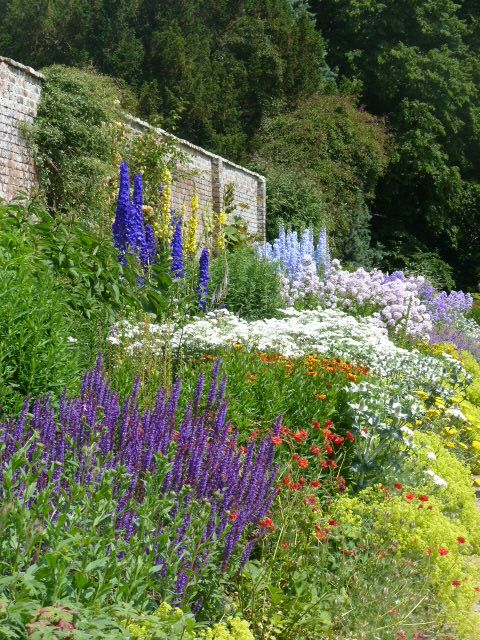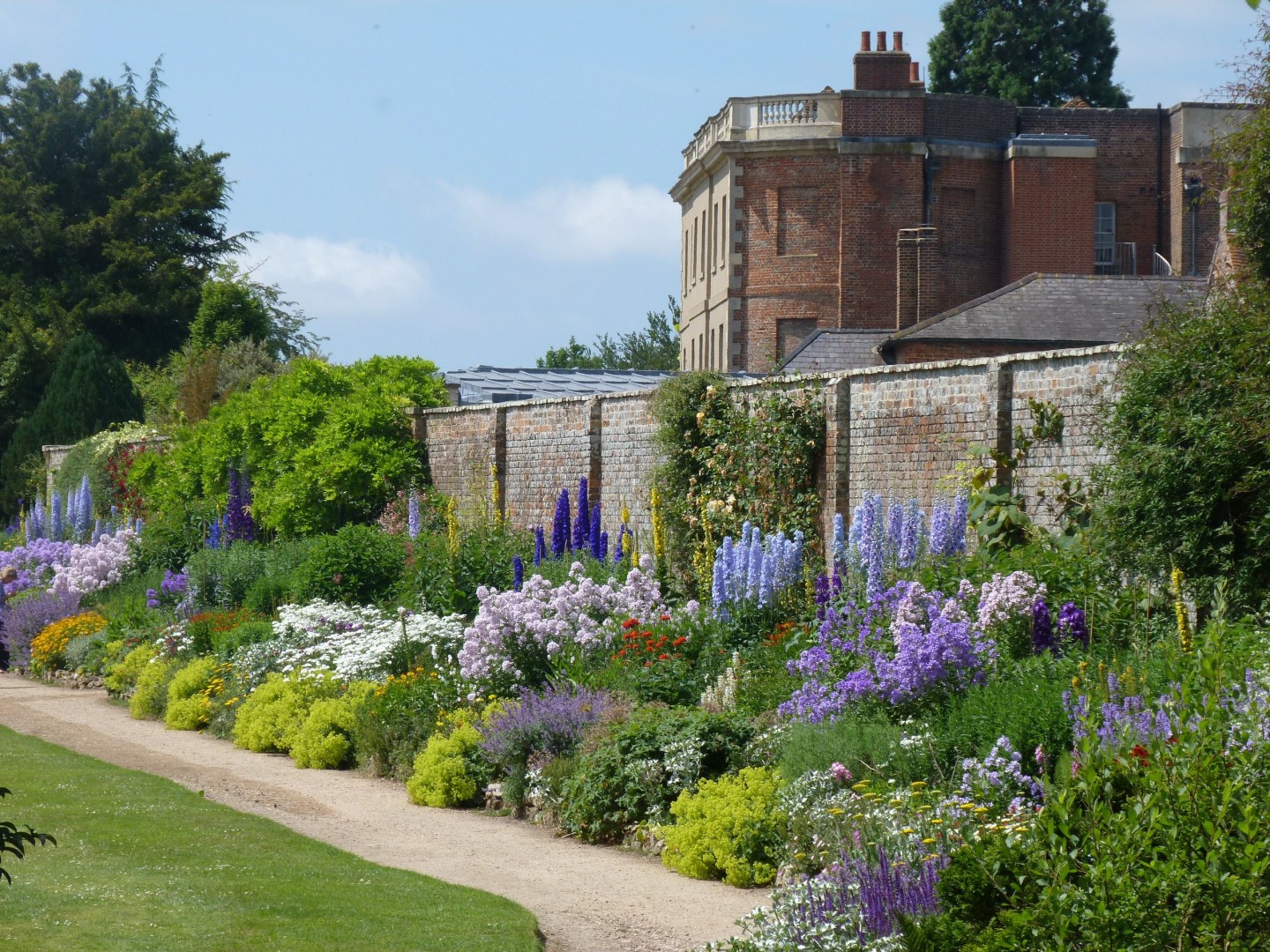From May to July, delphiniums, also known as larkspur, provide regal elegance in our gardens. Visitors to RHS Chelsea Flower Show will see magnificent flower spikes which will take your breath away. These stately perennials really do deserve their place in Royal gardens and are grown both in the borders at Buckingham Palace and in King Charles III’s gardens at Highgrove in Gloucestershire. In fact, they are one of the King’s favourite perennials: the Delphinium Mighty Atom is prominent in all of the King’s gardens.
Delphiniums are extremely rewarding to grow. Their tall flower spikes, with columns of single to fully double flowering blooms, work well in contemporary or cottage gardens and are also wonderful as part of a flower arrangement. Due to their flower colour and structure, delphiniums are attractive to bees – another reason to plant these majestic perennials. To get the best from them you need to provide suitable growing conditions and giving them care.
 Before you buy your selections of plants, ensure you have a sunny, sheltered position where you can give the plants plenty of space. Delphiniums also need well drained but nutrient rich soil, so you will need to dig in manure or garden compost and, if you have heavy clay, you may want to add pea gravel to help with the drainage. Once planted they like to be kept moist without being over watered, so it is worth applying a mulch to the surface, using leaf mould or mushroom compost to help conserve moisture during warmer, drier months.
Before you buy your selections of plants, ensure you have a sunny, sheltered position where you can give the plants plenty of space. Delphiniums also need well drained but nutrient rich soil, so you will need to dig in manure or garden compost and, if you have heavy clay, you may want to add pea gravel to help with the drainage. Once planted they like to be kept moist without being over watered, so it is worth applying a mulch to the surface, using leaf mould or mushroom compost to help conserve moisture during warmer, drier months.
When it comes to selecting which delphinium to grow, choose quality named hybrid plants which will give you a reliable perennial and should bloom for several years as opposed to seed sown plants, which may not live for more than one flowering season. Select your colours to co-ordinate with your overall scheme. There is a wide selection available; from creamy-white, pale pink and mauve, to shades of blues, dark pink and deep purple. In fact if you are thinking of planting a black and white garden, delphiniums are a fantastic choice to give you maximum colour impact as you can opt for pure white to very dark purple, almost black in appearance.
Delphiniums are best planted in the spring but often do not become available to buy until early summer as they are coming into flower. If you do plant in May or June, it is particularly important that you follow the correct watering regime after planting. Position your delphiniums in groups of three, five or seven, leaving sufficient space between plants.
You need to water newly planted delphiniums regularly during their first summer, keeping the soil around the roots moist until they are well established; a mulch helps to retain moisture as the temperatures rise. Water well established plants at least once a week keeping the soil moist but not water logged. To get the best from your delphiniums, feed weekly with a potassium rich liquid fertiliser as soon as the flowers begin to emerge and until the end of August.
 It is important that you stake your delphiniums correctly: do not wait until they have reached full height to do this. If you are using tall bamboo canes, you can find the green covered varieties which are less obtrusive. Semi-circular metal supports are ideal and should be placed around the plants when they reach a height of 60cm. You can also create a supportive framework using Hazel stems which will become hidden by the foliage. If you are using bamboo canes, start when the plants are approximately 45 to 60cm tall; use three 1.2m canes per plant, with 30cms into the ground, splayed outwards slightly. Using green twine, tie from cane to cane, forming a cage in which the stems can sway. As the plants grow, add further rings to add additional support. It is important not to tie individual canes tightly to each flower spike as this leads to breakages.
It is important that you stake your delphiniums correctly: do not wait until they have reached full height to do this. If you are using tall bamboo canes, you can find the green covered varieties which are less obtrusive. Semi-circular metal supports are ideal and should be placed around the plants when they reach a height of 60cm. You can also create a supportive framework using Hazel stems which will become hidden by the foliage. If you are using bamboo canes, start when the plants are approximately 45 to 60cm tall; use three 1.2m canes per plant, with 30cms into the ground, splayed outwards slightly. Using green twine, tie from cane to cane, forming a cage in which the stems can sway. As the plants grow, add further rings to add additional support. It is important not to tie individual canes tightly to each flower spike as this leads to breakages.
After flowering, cut off the main flower spike just below the bottom florets which will encourage side shoots to grow. You may well get a second flush of flowers, albeit much smaller, during late August. In autumn, allow the foliage to die back and cut stems off to ground level. As delphiniums are hardy perennials, they can endure cold winters, but they will rot if the winter is excessively wet. Crowns can be protected by covering with stray staked with garden wire. If you are growing your delphiniums in pots, move containers to a sheltered position over winter as roots will be less insulated than when they are in the ground. Older delphinium plants will need to be lifted and divided in early spring every two to five years. Reinvigorate the soil and choose the most vigorous sections of the plants.
Delphiniums fall broadly into two groups: the taller growing species, hybrids of D. elatum and the shorter varieties of D. belladonna.
The Elatum group offers flower spikes up to 2m tall with an average plant width of 60 to 90cm. These clump forming plants flower from early to midsummer and will require staking at an early stage as the flower spikes are very heavy and can easily be snapped in the wind if not properly supported.
The Belladonna group have more loosely branched flowers with numerous side spikes, blooming in early and late summer. They grow to up to 1.2m and form clumps around 45cm wide.
Pacific hybrids, frequently sold in garden centres, are similar to the Elatum group but are slightly shorter growing to around 1.8m with a spread of 75cm. They are however short-lived perennials, best grown as annuals or biennials.
Images from a selection supplied by Waterperry Gardens









